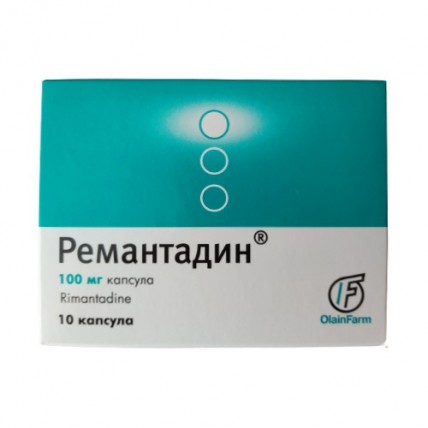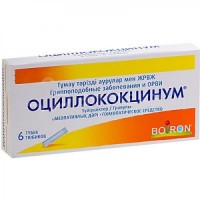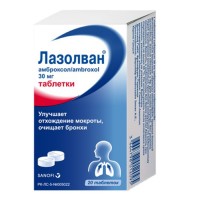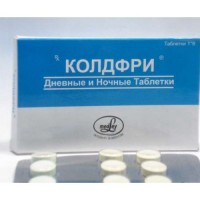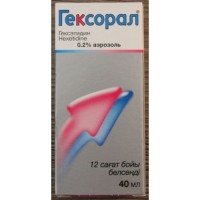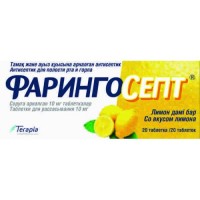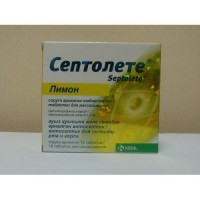Remantadine® (Rimantadine) 100 mg, 10 capsules
- $11.00
Compound
One capsule contains
active substance - Rimantadine hydrochloride 100 mg,
excipients: lactose monohydrate, potato starch, stearic acid, sunset yellow FCF (E110),
the composition of the body and cap of the capsule: titanium dioxide (E171), gelatin.
Pharmacological properties
Pharmacokinetics
After oral administration, Remantadine is well absorbed in the gastrointestinal tract, has high bioavailability, penetrates well into all tissues and body fluids, into the cerebrospinal fluid. About 40% of the active substance binds to plasma proteins. The maximum plasma concentration is reached after 5-7 hours. The active substance is extensively metabolized in the liver, undergoes hydroxylation, conjugation and glucuronidation. The elimination half-life averages 25 hours, in the elderly - 32 hours, in children - 13-38 hours. It is excreted mainly in the urine, 15% - unchanged through the kidneys.
Pharmacodynamics
Remantadine - a derivative of adamantane, has a pronounced antiviral activity. The drug is effective against influenza A virus, has no or little effect against influenza B viruses. Remantadine inhibits viral replication in the early stages of the cycle, possibly by disrupting the formation of the viral envelope. In the antiviral action of Remantadine against the influenza A virus, the specific protein of the M2 gene of the virion is important. In vitro, rimantadine inhibits the replication of three antigenic subtypes of influenza A virus isolated from humans - H1N1, H2N2 and H3N2. Remantadine does not affect the immunogenetic properties of the inactivated influenza A vaccine. Remantadine-resistant viruses have been isolated by using Remantadine in a closed environment.
Indications for use
- treatment of influenza at an early stage
- prevention of influenza during the epidemic season
Dosage and administration
Remantadine is taken orally after meals with water.
The use of the drug should be started immediately after the first symptoms of influenza appear. The therapeutic effect is more pronounced if the application is started within the first 48 hours of the disease.
Treatment of influenza: Adults dose is 100 mg 2 times a day.
Elderly people (over 65 years): The dose is 100 mg once a day.
The duration of the course of treatment is 5 days.
Flu Prevention:
The use of the drug should begin with the onset of an influenza epidemic. It must be taken during an influenza epidemic, but no longer
2 weeks.
The adult dose is 100 mg 2 times a day.
Elderly people and patients with a high risk of complications, the dose is 100 mg once a day.
Patients with impaired liver function
In case of severe violations of liver function, the use of the drug is contraindicated. Patients with impaired liver function of mild or moderate severity should consult a doctor before using the drug and, if necessary, adjust the dose: 100 mg once a day. Careful monitoring of patients in this group is necessary.
Patients with impaired renal function
In case of severe renal impairment, the use of the drug is contraindicated. Patients with impaired renal function of mild or moderate severity should consult a doctor before using the drug and, if necessary, adjust the dose: 100 mg once a day. Careful monitoring of patients in this group is necessary.
Side effects
Classification of undesirable adverse reactions according to the frequency of development: very often (≥ 1/10); often (≥ 1/100 to < 1/10); infrequently (≥ 1/1000 to
< 1/100); rarely (≥ 1/10,000 to < 1/1,000); very rarely (< 1/10,000); the frequency of manifestation is not known (cannot be determined from the available data).
Often
- insomnia
- nausea, vomiting.
Infrequently
- depression, euphoria, hallucinations
- dizziness, headaches, irritability, attention disturbances, ataxia, drowsiness, hyperkinesis, tremors, confusion, convulsions, changes or loss of smell
- ringing in the ears
- palpitations, heart failure, heart block, tachycardia
- hypertension, cerebrovascular disorders, syncope
- shortness of breath, bronchospasm, cough
- loss of appetite, feeling of dry mouth, abdominal pain, diarrhea, dyspepsia
- skin rash
- asthenia, fatigue.
Frequency unknown
- itching, papular rashes, generalized rashes, urticaria.
The frequency of side effects, especially from the gastrointestinal tract and the nervous system, increases when the recommended dose is exceeded.
In some cases, when the recommended dose was exceeded, lacrimation of the eyes, more frequent urination, fever, constipation, sweating, stomatitis, hypesthesia, eye pain were observed.
Usually side effects disappear after discontinuation of the drug.
If you experience any side effects that are not listed in this leaflet, or any of the side effects mentioned are particularly pronounced, please consult a doctor.
Contraindications
- hypersensitivity to derivatives of the adamantane group or components of the drug
- severe liver dysfunction
- severe renal dysfunction
- thyrotoxicosis
- children and adolescents up to 18 years of age
- pregnancy and lactation
- hereditary galactose intolerance, lactase deficiency
Drug Interactions
Remantadine reduces the effectiveness of antiepileptic drugs.
Adsorbents, astringents and enveloping agents reduce the absorption of Remantadine.
Paracetamol and acetylsalicylic acid reduce the concentration of Remantadine in the blood plasma and reduce its effectiveness.
Cimetidine reduces the excretion of the active substance from the body.
Drinking alcohol should be avoided, as adverse reactions from the central nervous system may occur.
Special instructions
Precautionary measures
Caution should be exercised in patients with diseases of the gastrointestinal tract, impaired liver and / or kidney function of mild or moderate severity, severe heart disease and cardiac arrhythmias, and the elderly. In these cases, it is recommended to reduce the dose of the drug.
With indications of a history of epilepsy and ongoing anticonvulsant therapy against the background of the use of Remantadine, the risk of developing an epileptic seizure increases. In these cases, the dose of Remantadine is reduced to 100 mg per day. If an attack develops, the reception of Remantadine is stopped.
Lactose. One capsule contains 148.7 mg of lactose. Should not be used in patients with rare hereditary problems of galactose intolerance, the Lapp lactase deficiency or glucose/galactose malabsorption.
The composition of the drug includes sunset yellow dye (E110), which can cause allergic reactions.
Features of influence on the ability to drive a vehicle or potentially dangerous mechanisms
Remantadine does not affect the ability to drive a vehicle or potentially dangerous machinery, but people who experience dizziness, headache or other side effects from the central nervous system should be careful.
Overdose
Symptoms: agitation, hallucinations, arrhythmia. Possible death.
Treatment: in case of poisoning, it is necessary to maintain life-supporting functions. In case of an overdose with symptoms from the central nervous system, intravenous administration of physostigmine is effective (1-2 mg for adults and 0.5 mg for children, repeated if necessary, but not more than 2 mg per hour). Remantadine is not excreted by hemodialysis.
Storage conditions
In a dry, dark place at a temperature not exceeding 25 ° C.
Keep out of the reach of children!
Shelf life 2 years
Do not use after the expiry date stated on the packaging.
